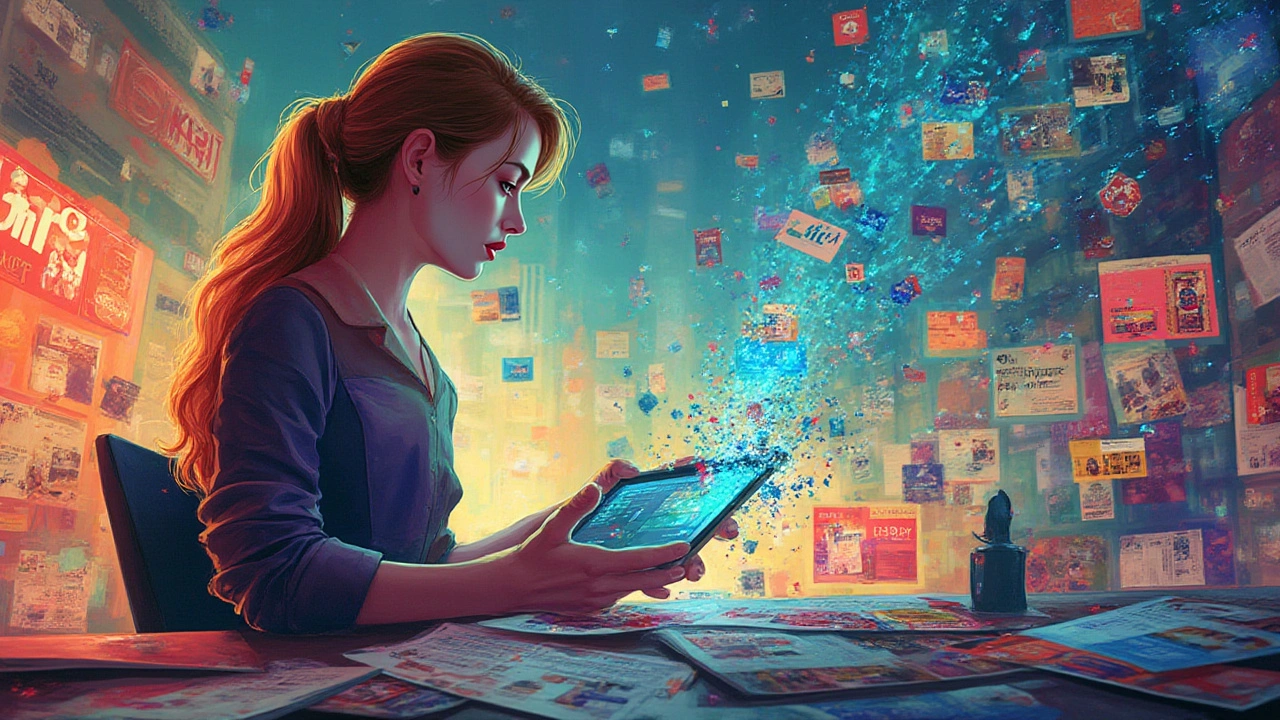Wake up and check your emails. There's a fresh newsletter full of personalized tips, a quirky social post from your favorite brand, and an ad that finally understands what you want. What if I told you a single AI tool, ChatGPT, helps power all these? This isn't a peek into a sci-fi future—it's the digital marketing world in 2025, where ChatGPT isn’t just a gadget for tech geeks. It’s quietly running the show behind the scenes. Marketers use ChatGPT to write content that actually sounds human, automate campaigns without losing that personal touch, and generate ideas that used to take entire brainstorming sessions. Even if you don’t know it, chances are you’ve interacted with at least one piece of AI-generated marketing today.
The Lightning Rise of ChatGPT in Marketing
Remember a time when content marketing meant writing every blog post, newsletter, and product description by hand? It’s wild how fast AI has flipped this script. ChatGPT, launched as a language model just a few years ago, now ranks as one of the most-used AI tools in marketing teams worldwide. Its growth has been stunning: according to a 2024 Statista report, nearly 48% of digital marketing agencies in North America now use some form of ChatGPT in daily operations.
So, how did it happen? For years, marketers wrestled with two main headaches: scaling content creation and keeping it fresh. ChatGPT jumped right into that pain point, churning out blog posts, emails, ad copy, captions, and even product reviews on demand. And it doesn’t spit out robotic text. When set up right, it nails your brand’s voice, adjusts for tone, and even throws in the kind of casual wit that readers love.
Let’s talk numbers for a second. A 2025 Salesforce study revealed that AI-driven content now generates, on average, a 28% higher click-through rate compared to human-only text. Users are spending more time on brands’ websites, and the bounce rate has dropped by nearly 15% for brands using ChatGPT content.
It doesn’t end with words on a screen. ChatGPT gives marketers the power to automate repetitive tasks. Scheduling and running email campaigns used to eat up hours. Now, ChatGPT can analyze sign-up forms, group subscribers by interest, and suggest custom email flows in seconds. Routine tasks like replying to common customer queries or sorting leads now rely on fine-tuned AI, freeing humans to work on the creative, big-picture stuff.
Sometimes, using ChatGPT feels like having a super-creative sidekick. Writer’s block? Fire up the chatbot and see what pops out. Stuck naming a new product? ChatGPT can throw out a dozen catchy ideas in a heartbeat.
Want more proof? Look at the e-commerce world. A major online retailer reported a 35% faster turnaround on seasonal ad campaigns after integrating ChatGPT into their creative workflow. Even smaller shops are seeing wins: one boutique skincare brand mentioned their monthly social media engagement doubled since AI started scripting posts and DMs.
You might wonder: won’t this make everything sound the same? The short answer—no. Brands that put in the work to build strong, unique prompts and refine their AI models get content that’s hard to tell apart from in-house, human writing. Think of it as an amplifier for your team, not a replacement.

Winning with ChatGPT: Real Tips and Proven Strategies
Sure, ChatGPT is powerful, but only if you use it right. It’s like getting the world's best kitchen gadget—it won’t cook dinner if it stays in the box. So, what are top marketers doing to squeeze the most out of AI today?
First, they embrace prompts like gold. Crafting the right AI prompt is now the digital marketer’s secret weapon. A vague request (“Write a blog post about shoes”) brings generic results. But if you build a detailed prompt (“Write a playful article targeting 25-35-year-old women about how sneakers make you feel powerful at work, and end with a pun”), ChatGPT delivers gold. Companies like Notion and Duolingo have whole teams tweaking prompts for best results.
Good AI needs good data. Marketers use clean, real-world examples, past campaigns, and actual customer insights to train or fine-tune their ChatGPT models. If the training data is strong, the output is better than most freelancers—and far quicker. An apparel brand in Los Angeles boosted their PPC conversion rates by over 20% after including specific customer questions and complaints in their ChatGPT training set.
Feedback loops matter, too. After ChatGPT generates content, don’t just hit publish. Top brands analyze the content’s performance—looking at open rates, likes, and comments—and use that data to edit prompts and responses for next time. Many are integrating ChatGPT with analytics dashboards (like Google Analytics or Power BI) for real-time tracking.
Let’s break down a typical workflow using ChatGPT for digital marketing:
- Content ideation: Marketers input trends, past winners, or campaign ideas. ChatGPT outputs a tailored idea list.
- Content drafting: The AI writes first drafts, blog articles, scripts, or captions in your tone of voice.
- Personalization: ChatGPT tweaks content to match different audience segments (like making separate email flows for new vs. repeat buyers).
- Automation: AI schedules, launches, and sometimes even A/B tests emails, ads, and posts.
- Performance review: Marketers check stats, feed insights back into ChatGPT, and repeat.
If you want to avoid sounding robotic, add your own polish. I usually run my AI drafts through a round of human edits—sometimes that means tossing in an inside joke only my long-time readers will get, or referencing an event (like the local Taco Festival Kendrick and I went to) so it feels real.
Voice search is another huge win. As more people skip typing and start talking (“Hey Google, which shampoo is best for curly hair?”), ChatGPT helps brands tweak content for these questions. Natural language content gets featured more often in answer boxes and voice search results.
If you're wondering about numbers, I dug up a few. Here’s how companies have seen impacts since AI tools (especially ChatGPT) became part of their digital marketing:
| Metric | Pre-ChatGPT (2022) | Post-ChatGPT (2025) |
|---|---|---|
| Average Content Output (articles/month) | 10 | 35 |
| Email Campaign CTR | 2.8% | 3.6% |
| Social Media Engagement Rate | 3.1% | 5.2% |
| Time Spent Creating Content | 12 hours/week | 4 hours/week |
Tips from pros who are nailing it:
- Focus on prompt quality—don't be afraid to experiment and be specific.
- Bake in your company’s story and unique voice, not just facts.
- Set up clear feedback loops between AI output and real user responses.
- Keep a human review in the workflow—AI is smart, but your experiences make content pop.
- Stay current and refresh prompts based on audience trends and seasonality.

Is ChatGPT the New Standard in Digital Marketing?
Fast-forward to today—and yes, ChatGPT is setting the pace for digital marketers everywhere. It’s not about replacing humans; it’s about raising the bar for speed, creativity, and connection. The world’s moved on from only using ChatGPT to churn out generic copy. Now, teams use it for brainstorming, brand storytelling, campaign personalization, and quick-turn market research. Data from HubSpot’s 2025 State of Marketing survey says brands using AI for both short-form and long-form content are 37% more likely to see “significant ROI improvement” compared to those sticking to manual workflows.
Let's talk about innovation. ChatGPT already works seamlessly with tools marketers love—think Zapier, HubSpot, Shopify, and custom-built analytics platforms. Integration makes it possible to automate everything from email series launches to PPC ad copy tweaks, without ever leaving your dashboard. Many agencies now offer dedicated ChatGPT workflow audits as part of their service packages.
There’s this worry that all AI-generated content will blur together. But really, it depends on the creator. ChatGPT gives marketers the superpower to scale up ideas while keeping things interesting and tailored, not just fast. A global beverage brand used it to make dozens of region-specific ad campaigns in seven languages—each with the right humor, slang, and references for its market. The CTO credited “our friendly AI chatbot” for a record quarter in reach and conversions.
What about the team behind the scenes? ChatGPT isn’t pushing people out of marketing—it’s changing their day-to-day. Junior marketers don’t spend hours proofing newsletters; they’re mapping out new campaign ideas. Copywriters go from drafting to curating and refining, focusing on quirky hooks and deeper storytelling. Managers have better data, automate reports, and spend more energy on creative leadership and team growth.
One underrated benefit is accessibility. ChatGPT gives smaller teams in emerging markets the power to compete with bigger brands. You don’t need a Hollywood-sized budget now—just the right prompts and a dash of creativity. For new businesses, it’s a game changer. I’ve seen indie brands launch entire product lines—website copy, social campaigns, and FAQ pages—just using AI and a little hustle.
Where could this go next? Expect ChatGPT to dive even deeper into marketing analytics: real-time reporting, instant campaign tweaks, and predictive personalization. AI isn’t just reacting—it’s starting to anticipate trends before they go mainstream. Imagine launching flash campaigns based on what’s trending tomorrow, not yesterday.
So, is ChatGPT a digital marketing must-have? At this point, trying to manage digital campaigns without it feels like baking a cake with one hand tied. Embrace the tech, get smart with your prompts, and let your creativity do the rest. The brands winning right now aren’t worried about robots taking over—they’re using AI to tell better stories, get closer to their customers, and actually have more fun with their work.


As a passionate marketer, I strive to connect businesses with their target audiences in creative ways. I specialize in developing and implementing digital and content marketing strategies. I am currently working as a Marketing Manager at a renowned firm. In my spare time, I love to share my knowledge about online marketing through my blog. I believe that continuous learning and sharing of knowledge are keys to growth.